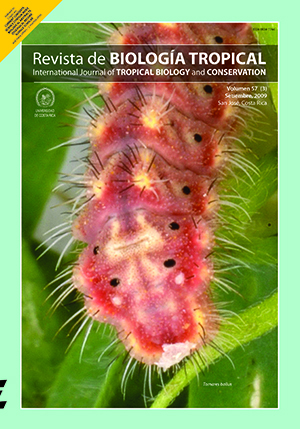Abstract
Zooplankton sampling was carried out monthly from January to December 1990 at station A near the coastline, and station B near the reef barrier, in a tropical coral reef lagoon in the Mexican Caribbean Sea. Samplings were made at midnight, near surface, with a conical net (mouth 0.40 m, mesh 330 ?m) for 10 min. Salinity varied from 35.1 to 36.3 psu and temperature from 26.3 to 30.2 °C. The Bray-Curtis test applied to these results has defined two seasons: the dry season from November to May, and the wet season from June to October. A total of 37 zooplankton groups were found. Copepods were the most abundant contributing 49.0% of the total capture with Acartia espinata, Calanopia americana and Farranula gracilis as the most numerous. In the total zooplankton, however, cirripeds captured in only 15 samples of 24 were second in abundance (20.9%). Decapods, present all year-round and more abundant during the wet season, were third and contributed 19.2%. The rest of the groups were scarce and only amphipods (2.4%) and larvaceans (2.0%) were relatively abundant. The abundance of captured organisms correlated with the abiotic factors measured, thus, in the dry season, abundance was lower (mean 7.3 orgs/m3), while in the wet season the mean catch was 36.8 orgs/m3.##plugins.facebook.comentarios##

This work is licensed under a Creative Commons Attribution 4.0 International License.
Copyright (c) 2009 Revista de Biología Tropical
Downloads
Download data is not yet available.






